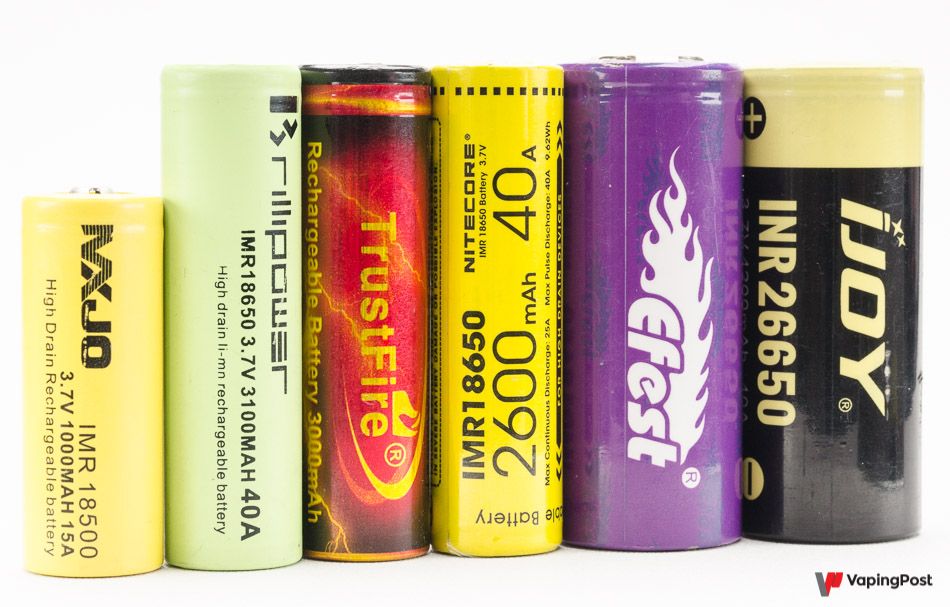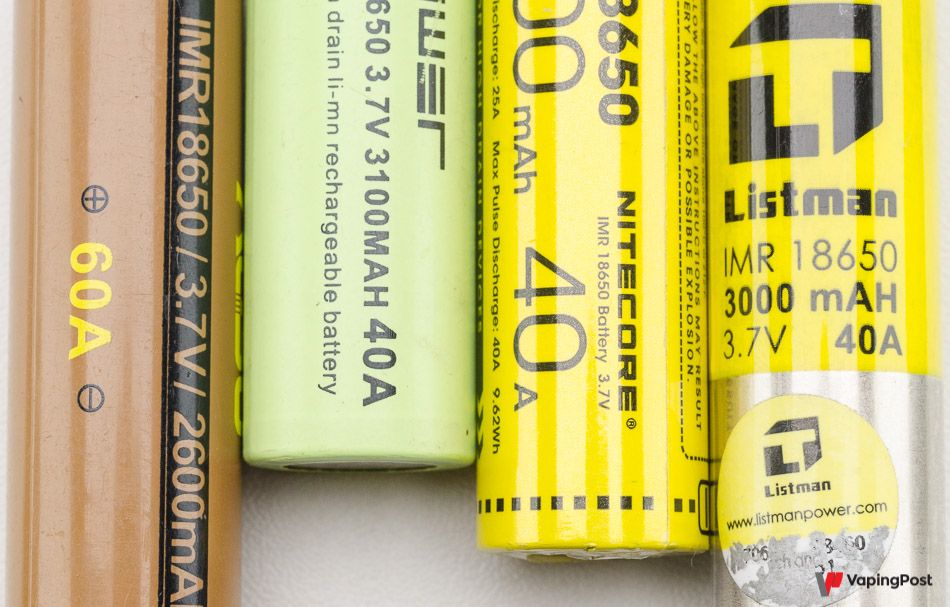Battery brands
There are countless battery brands, whether you are talking about 18650 or 26650 batteries, or the new 20700 and 21700 batteries. However, there are some brands that you can rely on, and the others. Let us show you around the wonderland of batteries and its many unicorns.
Manufacturers
We will begin with genuine battery brands, those bearing the name of the company that actually manufactured them. You will often read that there are only 4 battery manufacturers: Samsung, LG, Sony, and Panasonic/Sanyo. That is true… and not so true. They are the 4 major manufacturers well-known for the quality and reliability of their productions, and who sell their batteries under their own brand, but there are actually many other factories producing batteries.
The strength of the Big 4, Samsung, LG, Sony and Panasonic/Sanyo, is that their production is approved by the major manufacturers of laptop computers, handheld tools, electric vehicles, and other major industries. They have a reputation and above all strict specifications to meet, and their very name evokes globally recognised brands well beyond batteries. And it doesn’t make any difference that the batteries are manufactured by subsidiaries (LG Chem for LG, Sony Konion for Sony, etc.)
In a nutshell, choose your batteries from one of these four brands, to the exclusion of all others for 18650 batteries. The characteristics claimed by these manufacturers are accurate, sometimes even slightly underestimated, which is far, very far from being the case of the distribution brands discussed below. With these four brands, you know exactly what you are buying, provided you do so from a trustworthy retailer. The latter point is critical for two reasons. The first is obviously to avoid clones, which are common for the best-selling models and often as similar to the original on the outside as they are dissimilar on the inside.
The second reason is less obvious. The battery manufacturing process is not always guaranteed. Once manufactured, the battery is tested. If it meets the specifications fully, it is rated as grade A and sold under its model number and the manufacturer’s brand. If it is slightly below, it is rated as grade B and sold to wholesalers or other industries for less demanding applications, without indicating the brand or model as they do not match. Finally, batteries exhibiting defects are classified as grade C.
As you can see, a retailer worth their salt will get their supplies from a reliable wholesaler, and you will get a grade A battery, meeting all the specifications of the model and you will obtain guaranteed performances. If you purchase your batteries anywhere… Why don’t you buy yourself a lottery ticket while you’re at it? Why would you be sold a grade B battery? It is necessarily purchased at a lower price from the manufacturer, which is excellent for the profit margin of the retailer who sells it on at the normal price.
Distribution brands or “rewrappers”

We have discussed the 4 main battery manufacturers, and, simply put, all the others are distribution brands. The corresponding batteries may be manufactured by one or the many other factories producing batteries, or come from one of the 4 manufacturers and simply have been “wrapped” in the specific protective plastic sleeve for distribution brand batteries. The latter scenario is by far the most commonplace.
For example, Efest, MXJO, Enercig, Basen, AW, Brillipower branded batteries can be described as “rewrapped” batteries, or “labelled” batteries in the specific case of Enercig, and not using the original manufacturer’s brand. Each brand has its own wrap, which is applied to a battery purchased from a manufacturer. A brand like Enercig adds its own label, while keeping the manufacturer’s original packaging. And surprises may be in store, on an important aspect of the vaping experience and especially of safety. Below you will find some pointers to guide you in your choice of e-cigarette batteries.
Artificially inflated characteristics

If you purchase a battery from the 4 main manufacturers and it specifies 3000 mAh and 20 A, its value is actually 3000 mAh and its can withstand 20 A continuously. In the case of rewrappers, the characteristics are almost always overestimated. Because a 40 A battery sells better than a 20 A one, and all the other rewrappers do it, this has practically become the norm. You will not find any 18650s over 30 A, or any 3000 mAh 18650s in excess of 20A. Except on labels of rewrappers of course, who have absolutely no misgivings about potentially putting you at the risk of using a battery at 40 A that is liable to explode over 20 A. All the details on this topic can be found in our article on key battery characteristics.
The uncertainty surrounding rewrapped batteries
With rewrappers, you haven’t the slightest idea which battery you are purchasing. They can even change battery while keeping the same reference number. One of the many examples of this? The iJoy 40A 3000mAh 20700. There is one version with 5 legs on the positive contact rated at 30 A (which is considerably overrated by iJoy), but also another version with 4 legs on the positive which is considerably inferior, with a higher internal resistance and voltage sag, which does not exceed 20 A. Both are sold as the same model, even though they are two completely different batteries. The iJoy 40A 3000mAh 20700 is therefore a 20 A or 30 A battery, depending on distribution.
Yet, in this case, they are easily identifiable if you are aware of the ploy. Efest, for example, has many models that have remained the same despite substantial battery changes, that are more or less invisible from the outside. The Efest 3000 mAh 35 A has been a rewrapped LG HG 2 (and as such a 20A battery) and also a 10 A LG MH1, and subsequently also an unknown 10 A battery. The packaging remains the same for brand recognition purposes, but the wrapped product changes based on business opportunities, without letting the consumer know of course. In a nutshell, you have no idea what you are buying, and rewrappers do everything to make sure that this is the case.
And that’s where the ambiguity lies. A rewrapped battery is not necessarily bad, and for some battery sizes such as 26650, you don’t have much choice, as they are not available from the 4 main brands. However, a battery from the 4 main brands is always as specified. For a rewrapped battery… this is very rarely the case.
Marketing at the cost of safety
Two years ago, many people swore by MXJO batteries, which were supposed to be the best in the world, particularly the famous and acclaimed MXJO 3000mAh 35 A 18650. On test benches, this battery resembles an LG HG2 (therefore 20 A) with lower performances (lower capacity and higher operating temperature). They were all the rage until it finally became clear that there is no such thing as an MXJO battery: as MXJO does not manufacture any batteries, there is no chance of them producing the best battery in the world. For all that, you will still encounter some MXJO devotees, the marketing pitch continues to be effective.
Rewrappers can sometimes keep the same overall marketing pitch but overrate the battery performances, which can prove to be hazardous in use, as the user is ultimately poorly informed on the technical properties of the product. This is fortunately not the case with all companies. A good example is the Enercig EC-C6 18650 / VTC6 3000mAh 25A. Enercig is a German brand which explains the source of its batteries to its customers, providing an assurance that you are not buying a clone or a grade B battery for example. A trustworthy distribution brand that clearly indicates the rewrapped battery model. In this case, the EC-C6 is a Sony VTC6.
Therefore, its specifications are 3000 mAh and 25 A, like the VTC6. Can the VTC6 withstand 25 A? Just like the latest VTC5A of merely 2500 mAh? Absolutely, you can look at Sony’s technical data sheet for the VTC6, and you will actually see 30 A in section 2.5. Followed by the words “With 80°C cut“, with temperature protection cutting off the circuit when the battery reaches 80°C. Without such a circuit, the technical data sheet is also unequivocal, the VTC6 is designed for 15 A. Therefore, the MDC is 15 A (see article on MDC, specifically defined by an operating temperature below 80°C), Sony is very clear on the matter, not 25 A (or 8C as indicated on the sleeve of the EC-EC6, which is equivalent to 24 A). And for good reason, at 24A, the VTC6 runs at… 98°C (independent test available on Mooch’s blog, the reference in the field), and you are no longer safe. As no electronic box offers the required protection for the temperature threshold, in our view, this is a 15 A battery, full stop. Why indicate 25 A on the packaging of the EC-C6, by the way, and not 30 A? It is most likely more credible than 30 A all the same, and the aim is to generate more credibility, as the brand is marketed as being different from the other rewrappers.
A final example? We could write an encyclopaedia on the topic, but let’s finish with the EHPRO 3000mAh 40A 18650. It is in fact also a 15 A battery, and not 40 as indicated on the battery itself. However, on their website (that one out of every 10,000 buyers will visit), the value given is 32 A… and above all it is strictly not recommended for e-cigarettes! Yet EHPRO is a well-known e-cigarette manufacturer! They are actually two separate companies, the company that sells these batteries (Bootes Technology Co, Ltd.) with the e-cigarette manufacturer’s exact name and logo has no relationship, according to the two companies, with the EHPRO that we know so well. The characteristics are incorrect, the brand is misleading, there is no need to go into any further details.
Marketing is the rewrapper’s stock in trade. You can buy a battery from one of the 4 manufacturers, or a marketing product that makes empty promises, the choice is up to you.
To find out more…
Batteries are a huge topic; we have written a series of articles examining the question.
- As straightforward as it might be, battery charging requires some pointers and was well worth devoting an article to help you do so safely and effectively.
- Buying the right battery is good, but keeping it longer is even better! For this reason, we have compiled a comprehensive tutorial on extending the service life of your batteries.
- However, a drop in battery performances, a battery impact or breach of the protective sleeve is bound to happen eventually. It is important to know when to replace a battery and how to dispose of it.
- For those who want to find out more, our article on key battery characteristics explains everything you need to know about the battery capacity and maximum discharge current, and how they are determined.
- And if you want to understand how to optimise your battery choice and use, our article on battery specifications goes into more detail on the concepts of internal resistance, voltage sag, rated voltage, and provides details on the different chemistries.
- Finally, if you are one of the many people who believe the serial / parallel battery configuration or set-up resistance to have some importance in terms of battery life or the current drawn from batteries in an electronic box, our article on choosing batteries in an electronic box is for you.
- On another note, an article on e-cigarette battery explosions. As the media feast on these stories, despite them being extremely rare, we thought it was important to review this explosive topic to understand it, and above all prevent it from happening to you.
Don’t forget!
- Never use a battery beyond its specifications, both for battery life and your safety.
- Always carry batteries in suitable protection; most of the rare accidents that occur are linked with transporting unprotected batteries.
- Only use batteries that are in perfect condition, free from scratches or impacts.
- Never throw a battery away, place it in a specific recycling container.













